The Construction of a Regional Cuisine: Tosa Ryori in Kochi Japan
Christopher Laurant (Graduate Student, Université de Montréal)
On a bright crisp morning, I made my way to a roadside farmer's market outside Kochi city. Once a week, the restaurant on the second floor of the market opens its kitchen to groups of elderly women so that they can prepare local home cooked meals for scores of hungry customers. When I arrived at 8 a.m., the kitchen was already bustling with activity. Inside, every inch of space was taken over by pots or septuagenarians. The smell of dashi broth and soy sauce floated in the air as the sounds of chatter and the banging of pans resonated in the sterile workspace. Without hesitation, they put me to work slicing bamboo shoots, mixing crumbled tofu, and frying vegetables in tempura batter. All the while, the gray-haired cooks, the repository of traditional cooking knowledge, asked me to try their food to make sure it tasted "right."
A week earlier, a classically trained Japanese chef had confided in me that he was not exactly sure what defined the traditional cuisine of Kochi called Tosa ryori. What makes a regional cuisine? Is it a distinct flavor? Is it particular dishes, ingredients or techniques? Or is it a flexible term that is used to express regional identity and create economic opportunities?
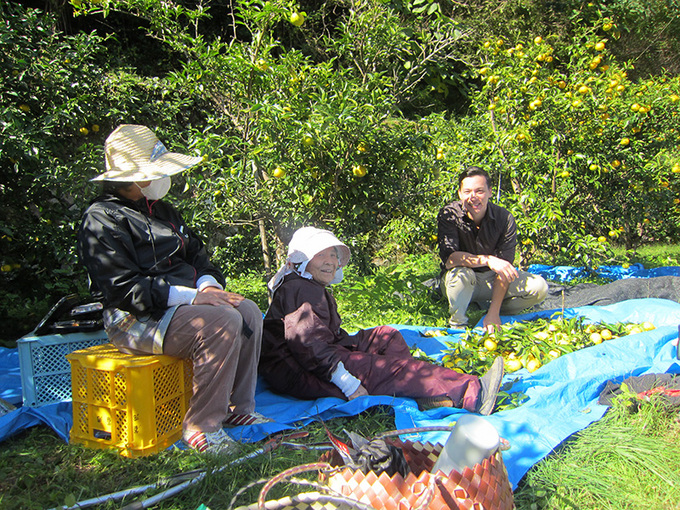
Yuzu picking in Umaji Village, Aki-gun, Kochi
Economic imperatives
In order to better understand the culinary tradition of Kochi, it might be useful to provide some background information. Kochi is the most southern prefecture in the island of Shikoku. Although it covers the largest area, it has the smallest population of the island's four prefectures. Kochi is bordered on the north by a wide range of mountains and to the south by the Pacific Ocean with most of the population concentrated on the narrow coastal plain. These natural boundaries have effectively isolated the region contributing to a unique dialect, religious celebrations and cuisine. The region is historically significant for the rest of Japan and residents take great pride in past heroes that were instrumental in the democratization of the country. For instance, Sakamoto Ryoma who helped overthrow two hundred and sixty years of military rule is a ubiquitous figure in Kochi culture. Today, sake brands and traditional confections named after the man compete with contemporary dishes like the "Ryoma burger" for a piece of the emblematic figure. The economy of the region, heavily relying on fishing and farming, is intrinsically tied to its food. Unsurprisingly, the seafood and vegetables of the region are purported to be among the best in Japan.
With the second lowest per capita income in Japan and few industries besides agriculture, Kochi cuisine plays a central role in the economy of the region. In this context, Tosa ryori, the cuisine associated with traditions and the past, serves the double purpose of attracting tourists and promoting food exports from the region. The image of the traditional village called furusato has been long used to promote the idea of the rural village as the repository of true Japan and, hence, figuratively as well as economically, sell this image to the rest of the country. In short, the prefecture does the best it can with the limited capital at his disposition. Local government and business associations also play an active role in exploiting this cultural resource by promoting the cuisine and products of the region in order to revitalize its dwindling economy. Recently, Kochi officials decided to endorse the consumption of wild game cuisine christened, gibier ryori. The idea was to keep in check the boar and deer populations that were raising havoc in the rice fields, while revitalizing the economies of rural mountains villages. This objective would be implemented through the promotion of the cuisine in food events coupled with monetary incentives for every animal culled.
As seen, in the Japanese context the construction of regional cuisine can be fostered by the allure of economic gain. Merchandizing one's identity and culture through cuisine comes with some drawbacks as identity can clash with economic opportunity. In negotiating the forms of authenticity, Kochi residents might have some qualms about having their culture put up for sale. It is a fine line to walk when one attempts to negotiate authenticity with economic opportunities. A commercialized version of regional cuisine might be sold as a representation of local culture when it is in fact the creature of a market economy. However, the goal of my research is not to debate the authenticity of a cuisine, but rather to breakdown the various processes that shape the contemporary expression of it.
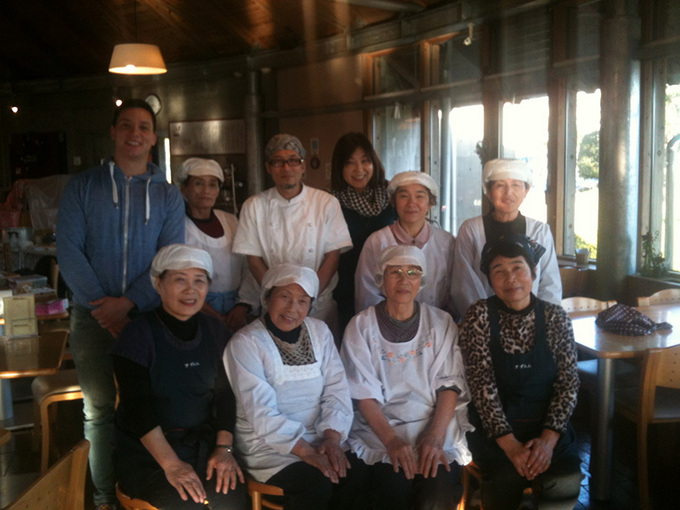
Group offers home cooked meals at the farmer's market
Legacies of the past
In the case of Kochi's cuisine, regional identity is a major player in molding what people from a region choose to eat and by consequence chooses to use as a proxy to represent their regional culture. Identity, a topic extensively discussed in cultural anthropology, is fostered through a complex dynamic that in the case of food heavily relies on group belonging and sensory memories. Kochi residents identify with regional cuisine in order to become part of a larger imagined community that exists through opposition with outsiders. Residents also identify with food because of specific memories that are associated with certain dishes or flavors endemic to the regional culture. When homesick, Kochi transplants living in the capital can experience a taste of their native home in "antenna shops" that sell specialties of their region. Hence, nostalgia for one's village or one's family comes alive in the food one remembers.
Cultural traditions are closely tied to representations of the past. Whether a tradition is the product of authenticity or invention is irrelevant as people find solace in the idea of continuity with a past that lives unchanged in the present. In Kochi, traditional cuisine is an essential part of the region's rich traditions and is itself linked in obvious and subtle ways to the past. The more obvious link is the usage of the name Tosa. Tosa han, the name of the feudal domain that is now Kochi prefecture is intrinsically tied to the rich history as alluded to earlier. In invoking the past, it is common practice to attach the word "Tosa" to products or dishes from the region of Kochi. However, ancient names are not enough if one wants to create a sense of permanence in a culinary tradition. Myths of origins are a fundamental part of the discourse that helps build a cuisine. One such story is the one about seared bonito or katsuo tataki an emblematic dish of the region. According to legend, katsuo, which were abundant in the sea near Kochi, would be consumed as soon as the fishermen hit the beach. These fishermen were not the educated diners of the capital and were squeamish about eating raw fish. The freshly caught fish were filleted using a fishing knife, seared over driftwood and rubbed with sea salt as soya sauce was beyond a fisherman's means. This story, although relying on few facts, helps anchor this traditional dish in the collective consciousness of the region.
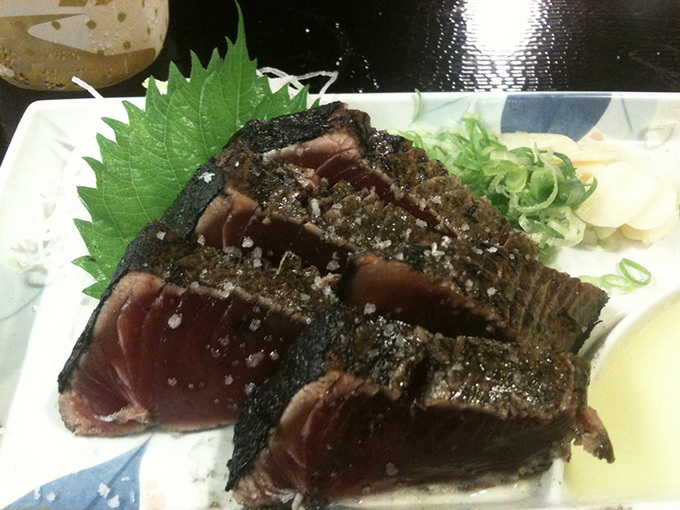
Salt seared bonito at Hirome Market
People and places
Certain processes play a greater role in shaping the image of the regional cuisine of Kochi. First, cooking education is central in transmitting the forms (esthetics of a dish, technique of preparation) and values (symbolism of elements, proper taste) associated with a cuisine. Learning how to cook is performative in nature, as it is transmitted through practice rather than discourse, and takes place in cooking schools, in kitchen apprenticeships, and in households. Second, restaurants are key players in that their interpretation of the regional cuisine often becomes the legitimate one. Chefs, the creative minds behind these restaurants, are trendsetters that inhabit the gray area between tradition and innovation. In this system, chefs are not only the gatekeepers of traditional cuisine; they are also ambassadors of regional taste to outsiders. Third, local government is particularly active in fashioning the regional cuisine of Kochi. Kochi officials are much implicated in establishing the prefecture's cultural policy through publications, funding and promotion of certain facets of the regional cuisine. More importantly than shaping the views that Kochi residents have of their food, local government, while seeking to promote tourism, shapes the view that people have of the cuisine outside the prefecture.
As far as research sites, the RKC Professional Cooking School and the Hirome Market have both been invaluable sites of inquiry. The RKC Professional Cooking School is the only professional cooking school in Kochi. The school's curriculum is divided amongst Chinese, Western and Japanese courses with the former heavily influenced by local flavors and regional cuisine. The school is a major authority on the regional cuisine of Kochi contributing to many publications on the subject. The cooking school is not only the site of transmission of regional cuisine, it is also a nexus point for the local food community helping support research groups, food conferences and degustation events. The second site, the Hirome Market, is a popular indoor market with many small shops that sell local specialties. The market, although not the best or the most authentic food destination in town, attracts crowds of tourists as well as locals on a daily basis. According to their website, the mission of the market is to spread, translated as hiromeru, the food and culture of Kochi. Local specialties at the market are meant to be shared around large tables in the company of friends or new acquaintances. Commensality, the act of sharing a meal, appears in this market as a most salient feature of the food culture of Kochi.
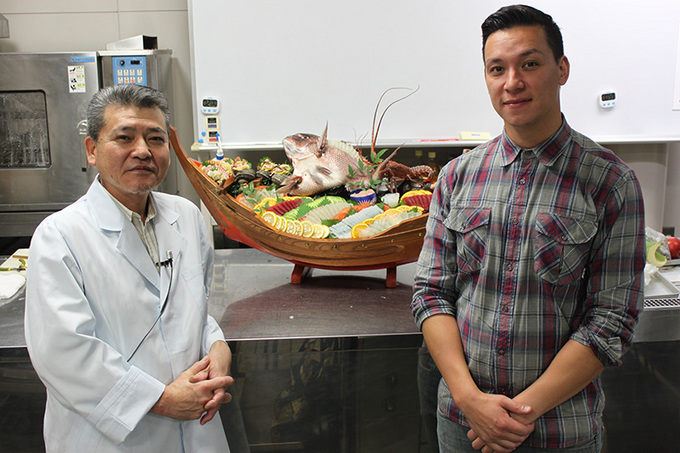
Receiving a cookery training at the RKC Professional Cooking School
Defining regional cuisine
Regional cuisine lives in the minds of the people that experience it in the form of emblematic dishes. For instance, Kochi residents will agree that katsuo tataki is a representative element of the regional food culture. Widely available in coastal regions, it is broadly consumed in the prefecture and extensively marketed outside of it as a symbol of the region. Still, the dish's preparation is far from being homogenous with different marinades, cutting styles and toppings as one moves around the prefecture. Sawachi ryori, a large serving plate used on special occasions, is another dish that all Kochi residents can identify with. On these plates, assorted raw or cooked regional dishes are arranged in a coherent whole following specific esthetic rules. The story goes that Kochi women, confined to the kitchen and excluded from dinner celebrations, devised a way to serve all food on these large plates in order to be able to eat and drink around the same table as men. Interestingly, answers can also be found when one looks at the importance of commensality in Kochi culture. In the past, sawachi was used for religious celebrations where resources, in this case various dishes, were pulled together to reinforce ties within the community. Sawachi is then a potluck of sorts where people share a bit of themselves and where the diversity of various elements from within a community are expressed in the form of a unified symbolic representation.
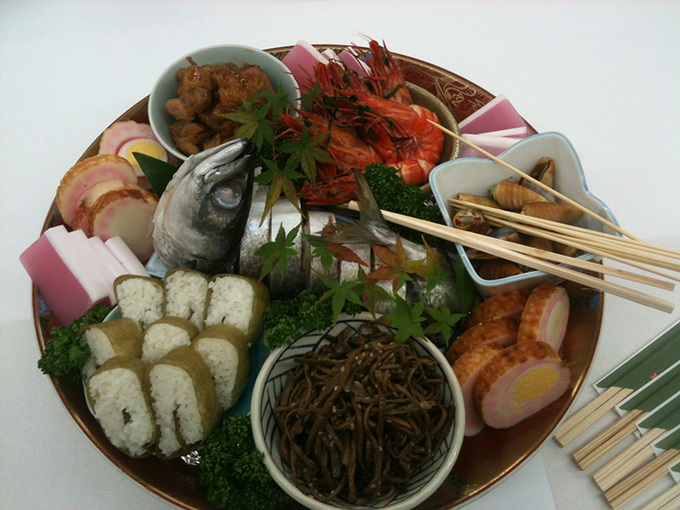
Sawachi ryori
A clear definition of the regional cuisine of Kochi seems to be elusive as even "experts" can have widely ranging definitions. Practically speaking, the region of Kochi is far from being a homogenous cultural entity with widely ranging culinary practices from east to west, in the mountains and near the sea. To break it down further, every village, and even household, has a slightly different way of interpreting regional cuisine. Yet, studying a regional cuisine is not a lost cause as there is some measure of consensus on what constitutes the cuisine of the region. Furthermore, Kochi cuisine is very much alive in the minds of the people who partake of it. Just as any cultural concept, the cuisine of Kochi is an entity that is fluid and unfixed. As an idea, it has a tremendous influence on the construction of regional identity. It is important to expose the symbolic and economic function of this regional cuisine while keeping in mind that most residents, in particular the younger ones, do not consume it on a daily basis. The fact that it is the cuisine of grandparents and special occasions serves to further enshrine it as a central element of the regional culture. Tosa ryori serves multiple purposes that are at times pragmatic and at other times symbolic. This almost palpable cultural entity is, however, far from static as it is always subject to numerous forces that transform its character and reinterprets its definition.
 Christopher Laurent
Christopher Laurent
Graduate Student at Université de Montréal. The Japan Foundation Japanese Studies Fellow in 2014. His research theme is "Consuming the Local: Regional Cuisine and Rural Revitalization in Japan." He has written many articles including "L'ekiben: la boîte repas des chemins de fer japonais" (Ekiben: box lunches on Japanese railways; L'Asie en 1000 mots, Université de Montréal 2014) , "The Many Lives of Mustard: Journey of a Familiar Condiment" (Cuizine: The Journal of Canadian Food Cultures, McGill University 2013).
Back Issues
- 2019.8. 6 Unraveling the Maker…
- 2018.8.30 Japanese Photography…
- 2017.6.19 Speaking of Soseki 1…
- 2017.4.12 Singing the Twilight…
- 2016.11. 1 Poetry? In Postwar J…
- 2016.7.29 The New Generation o…
- 2016.4.14 Pondering "Revitaliz…
- 2016.1.25 The Style of East As…
- 2015.9.30 Anime as (Particular…
- 2015.9. 1 The Return of a Chin…

